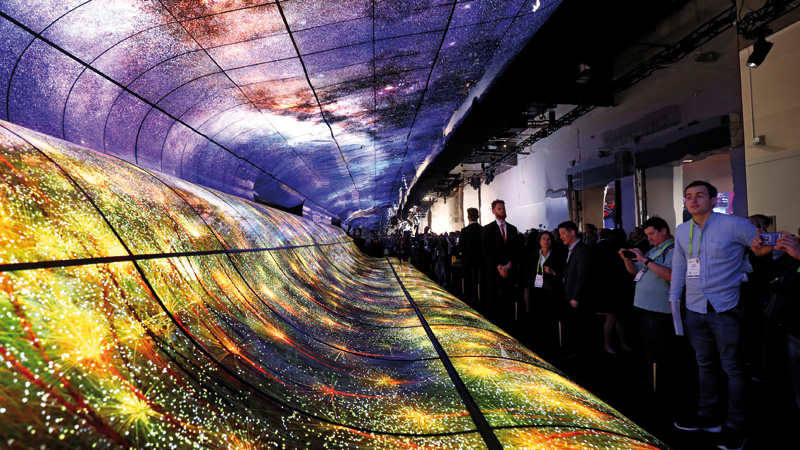

If we’re talking about televisions, then we need to talk about LG.
Last year at the CES tech fair in Las Vegas, LG became the first manufacturer to create a rollable display, showing off a prototype of this impressive innovation. This year, LG’s OLED TV R is close to being produced for broad use.
The TV is 65 inches when rolled out completely, but you can also choose to have it appear only partially, when it can be used as a clock and a weather display. When it’s fully closed, you can even still use it as standard soundbar for listening to music.
The CES fair in Las Vegas is a time for the world’s tech companies to present what they have managed to concoct over the past few months. As a staple of consumer electronics, TVs and entertainment systems often steal the limelight.
As such, LG is not the only one thinking about ways to avoid having a black box stare at you across the room all day, when it could perhaps be packed away until needed.
Samsung introduced its own innovative idea two years ago with The Frame: a television that looks like a decorative picture frame and can show pictures when it’s not in use as a TV. Now, Samsung is pushing this idea further after it introduced its MicroLED 75-inch TV.
This new technology could replace OLED, as it is supposed to last longer while offering at least the same quality colour palette, black colours and brightness. MicroLED hopes to also get rid of the burn-in effect plaguing so many screens.
Samsung’s 75-inch screen is much more generally marketable than the 146-inch display Wall they revealed last year. As with The Wall, the new 4K screen is made up of individual modules, which can theoretically be put together to make up all sizes or ratios — almost like building a display out of Lego blocks. This allows the TV to be customised to fit into any room discreetly.
Both new devices from LG and Samsung have one thing in common: Nobody knowns how much they will cost or when they could go on sale. But it’s very likely that neither will be cheap and therefore won’t be marketable for the general population. If we want to speculate, we can say that both televisions will probably be somewhere above the $5,000 mark.
All the big players — LG, Samsung, Sony, TCL — also unveiled their newest 8K resolution TVs. But as there aren’t that many films that have that kind of quality yet, the screen will rely on artificial intelligence software to improve the picture quality.
But it’s not only about the picture: the sound quality is also being improved with better software. Sony’s 8K models are able to place sounds coming out of a precise region on the screen, making it seem like the people on the screen are actually talking.
But although it’s cool to talk about the high-end products, that’s not actually where the money is really made. Most customers buy TVs for under $1,000 — according to Leif-Erik Lindner, Samsung’s Germany head, they make up 60 per cent of sales. And more and more people are buying TVs that are at least 55 inches.
Although they are cheaper, they also profit from the leaps and bounds the high-end models make in picture quality, albeit slightly later on. This means that the cheaper models are also getting better and better. Instead, they tend to be slower, or to have lesser quality in their colour palette or brightness.
If you take a look at the newest TVs in all price ranges, it’s obvious that televisions are no longer only about showing TV programmes. They are often the central nervous system of digital entertainment content, with all kind of services and streaming providers.
Samsung’s latest Smart TVs have added iTunes Movies to the row of providers like Netflix. And Apple’s AirPlay 2 is also set to be available on TVs from LG and Samsung which can play music as well as videos from your iPhone.
In addition to all this, TVs now have Google Assistant and/or Amazon Alexa installed, allowing you to connect all kinds of appliances and devices together. And this artificial intelligence learns to get to know your TV habits, what genres you enjoy and what you don’t like watching. All this helps to customise your content offers and suggestions.
A lot of the innovation is also focused on improving the voice recognition software so that it can understand normal language. For instance, LG’s 2019 models can understand commands such as “continue playing the show I was watching yesterday around this time.” — dpa
Oman Observer is now on the WhatsApp channel. Click here



